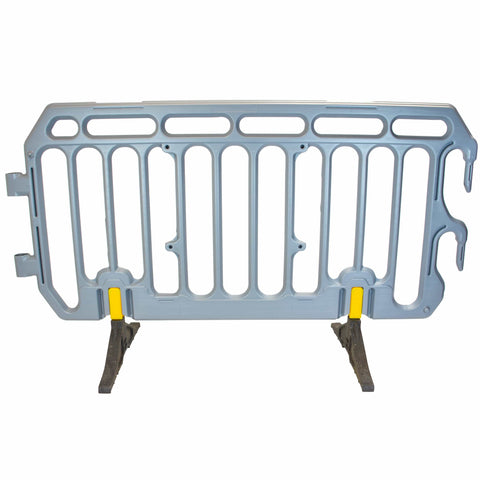Crowd Control Barriers - Vital Facts You Can’t Afford to Miss!
Posted by Pav Sprout on

Crowd control barriers are durable yet lightweight solutions. They are made to manage gatherings, increase safety, and make structured pathways in various settings. Commonly used at events, construction sites, and public spaces, they play a crucial role in queue management, perimeter security, and preventing overcrowding in high-traffic areas. Beyond just crowd direction, these barriers help maintain order, improve accessibility, and guarantee regulatory compliance.
In this blog, we explore some important factors about crowd control barriers that you’ll need to know before investing in them. Whether organising an event, securing a worksite, or managing pedestrian flow in busy locations, understanding how these barriers improve safety and efficiency is important.
What Are Crowd Control Barriers?
Crowd control barriers are sturdy, portable railings designed to manage crowds and regulate access to designated areas safely. They are widely used at events, concerts, festivals, sporting venues, and construction sites to create organised, secure environments.
These barriers can be linked together to form different configurations, from simple straight-line barricades to complex layouts that guide pedestrian flow. Depending on the setting, they may also be called crowd control barricades, pedestrian barriers, ped barriers, or pedestrian fencing barriers. Whether for safety, queue management, or perimeter security, these protection barriers are essential for maintaining order in high-traffic spaces.
Why Use Crowd Control Barriers?

Crowd control barriers are important for managing crowds and guaranteeing pedestrian safety at construction sites, concerts, football matches, and other events. Here's what they can help you with:
- Prevent overcrowding by guiding pedestrian flow
- Shield people from potential hazards
- Restrict unauthorised access
- Designate specific areas for attendees
- Keep emergency exits and pathways clear
Where Are Crowd Barriers Commonly Used?
-
Events, Festivals Concerts
Barriers create safe zones for audiences, staff, and security. They direct queues, prevent overcrowding, and guarantee smooth event organisation. Water-filled barriers can be particularly useful in high-traffic areas, offering both stability and impact resistance. -
Football Matches
Used around stadiums, these barriers manage queues, separate fans, and improve security. Met police barriers offer additional stability for big crowds. -
Construction Sites
Portable pedestrian barriers protect workers and the public by restricting access, shielding from debris, and guiding foot traffic safely around worksites. Whether for events or workspaces, crowd control barriers are important for maintaining safety and order.
Technical Traits of Crowd Control Barriers
Crowd control barriers are made to be durable, strong, and very easy to use. Made from high-density polyethylene, they can withstand heavy pressure from crowds while remaining lightweight for quick setup. Their rust-resistant zinc coating protects against weather damage, making them suitable for both indoor and outdoor use.
For added stability, these barriers interconnect using bolts and clamps, providing a secure crowd management system. They are also fire-resistant and made from recyclable materials, improving both safety and sustainability. Built to last, Chapter 8 barriers and other crowd control solutions provide a reliable, reusable option for event and site management.
Crowd Control Barrier Types
Crowd control barriers come in a variety of sizes and styles to suit different requirements. Most standard barriers are 2.3 meters wide and available in silver, red, or white. They typically feature two leg configurations:
-
Pedestrian Bar Barrier
These lightweight, detachable-leg barriers are easy to store and transport. Made from steel tubes, they do not have attached feet. That's why one can have flexibility in setup. Separate feet, such as flat steel or composite rubber, can be added for stability. For continuous runs, order one extra foot than the number of barriers.
-
Fixed-Leg Crowd Control Barriers
Designed for a more permanent setup, these barriers come with built-in feet, eliminating the need for separate components. Their all-in-one design makes installation quick and straightforward.
Securing Stages with Crowd Control Barriers
At concerts, fashion shows, and other live events, stage protection is crucial to maintaining order and guaranteeing performers' safety. Crowd control barriers make a secure perimeter around the stage. This prevents unauthorised access and keeps spectators at a safe distance.
Without proper barriers, crowds may push forward, and this can disrupt the event and even pose security risks. In some cases, performers may refuse to continue due to safety concerns. By strategically placing crowd control barriers, event organisers can prevent stage invasions, maintain a smooth event flow, and improve overall security.
Do You Need Crowd Control Barriers? Read These Facts Carefully Decide!
These most important facts about crowd control barriers will certainly help you decide if you need them or not. From managing crowds at events to increasing safety at construction sites, these barriers play a vital role in maintaining order and security. Exploring their benefits, features, and applications will give you a clearer idea of how they can improve crowd management and whether they are a necessary investment for your space.
